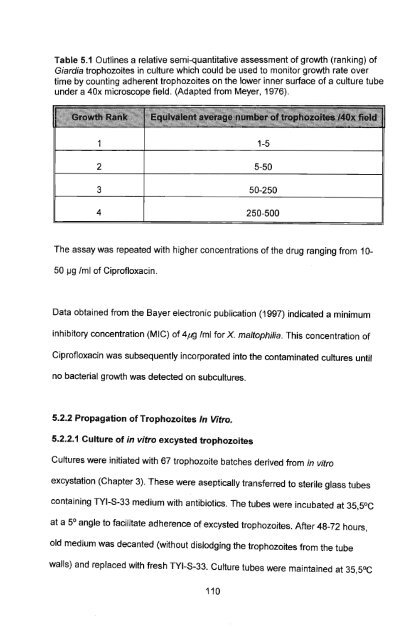in vitro culture and isoenzyme analysis of giardia lamblia
in vitro culture and isoenzyme analysis of giardia lamblia
in vitro culture and isoenzyme analysis of giardia lamblia
You also want an ePaper? Increase the reach of your titles
YUMPU automatically turns print PDFs into web optimized ePapers that Google loves.
Table 5.1 Outl<strong>in</strong>es a relative semi-quantitative assessment <strong>of</strong> growth (rank<strong>in</strong>g) <strong>of</strong><br />
Giardia trophozoites <strong>in</strong> <strong>culture</strong> which could be used to monitor growth rate over<br />
time by count<strong>in</strong>g adherent trophozoites on the lower <strong>in</strong>ner surface <strong>of</strong> a <strong>culture</strong> tube<br />
under a 40x microscope field. (Adapted from Meyer, 1976).<br />
1 1-5<br />
2 5-50<br />
3 50-250<br />
4 250-500<br />
The assay was repeated with higher concentrations <strong>of</strong> the drug rang<strong>in</strong>g from 10-<br />
50 J..Ig fml <strong>of</strong> Cipr<strong>of</strong>loxac<strong>in</strong>.<br />
Data obta<strong>in</strong>ed from the 8ayer electronic publication (1997) <strong>in</strong>dicated a m<strong>in</strong>imum<br />
<strong>in</strong>hibitory concentration (MIC) <strong>of</strong> 4pg fml for X. maltophilia. This concentration <strong>of</strong><br />
Cipr<strong>of</strong>loxac<strong>in</strong> was subsequently <strong>in</strong>corporated <strong>in</strong>to the contam<strong>in</strong>ated <strong>culture</strong>s until<br />
no bacterial growth was detected on sub<strong>culture</strong>s.<br />
5.2.2 Propagation <strong>of</strong> Trophozoites In Vitro.<br />
5.2.2.1 Culture <strong>of</strong> <strong>in</strong> <strong>vitro</strong> excysted trophozoites<br />
Cultures were <strong>in</strong>itiated with 67 trophozoite batches derived from <strong>in</strong> <strong>vitro</strong><br />
excystation (Chapter 3). These were aseptically transferred to sterile glass tubes<br />
conta<strong>in</strong><strong>in</strong>g TYI-S-33 medium with antibiotics. The tubes were <strong>in</strong>cubated at 35,50C<br />
at a 5° angle to facilitate adherence <strong>of</strong> excysted trophozoites. After 48-72 hours,<br />
old medium was decanted (without dislodg<strong>in</strong>g the trophozoites from the tube<br />
walls) <strong>and</strong> replaced with fresh TYI-S-33. Culture tubes were ma<strong>in</strong>ta<strong>in</strong>ed at 35,50C<br />
110
















